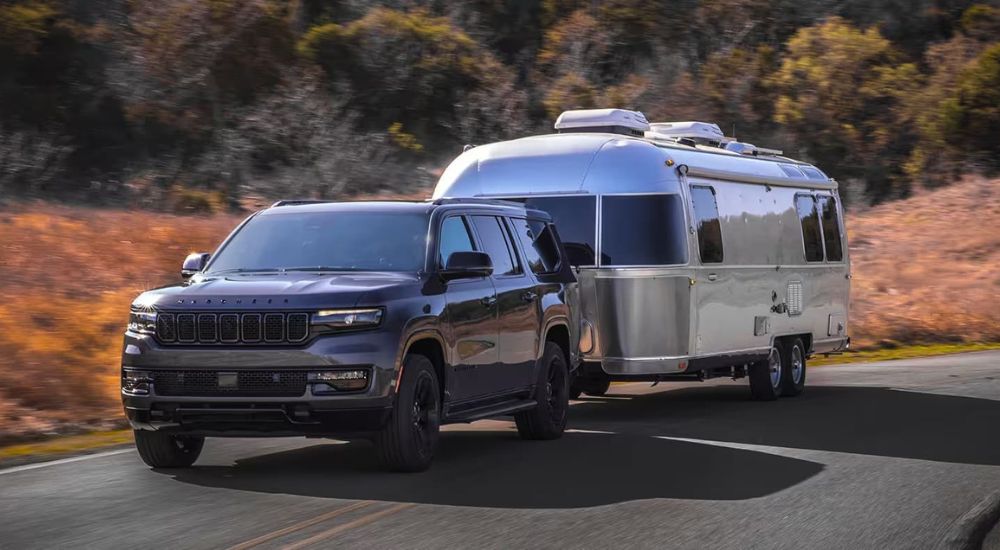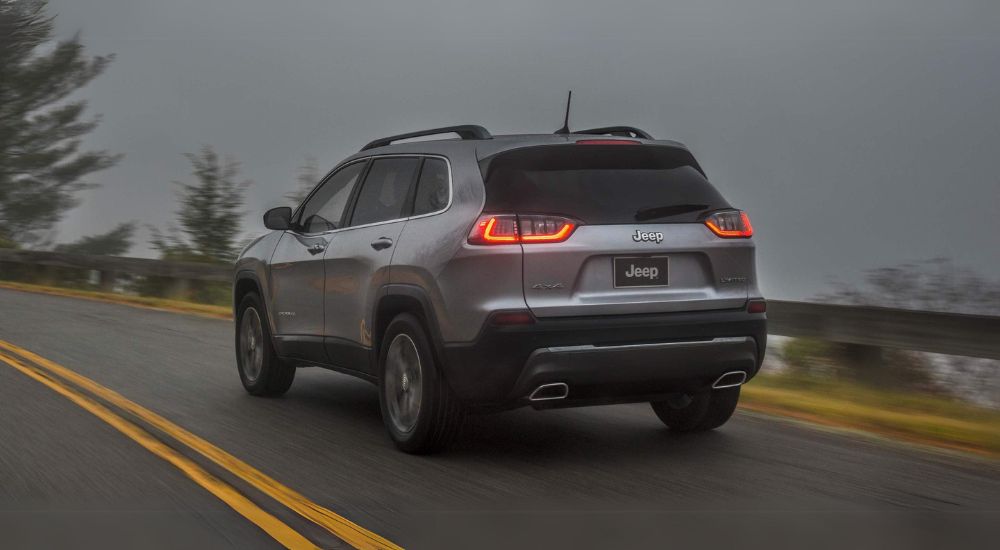Click or Press enter to Enter to Enable skip content option
Please Select a Section to Skip to

When browsing a used Jeep dealer‘s inventory for a new ride, you’re bound to notice a few things that stand out—one being Jeep’s unique design. Icons like the Wrangler have always stood out on the roadways—one look, and you know it’s a Jeep. This brilliant design wasn’t arrived at by accident but followed a popular philosophy from noted Chicago-based architect Frank Lloyd Wright. Wright stated, “..Form and function should be one, joined in a spiritual union.” Drivers can see the two pillars, form and function, working in unity when they explore a Jeep model.
The idea of form and function has been present in Jeep’s vehicles since the beginning, with the introduction of the Willys in 1941. The vehicle was designed for soldiers and medics during World War II. Its boxy shape kept the vehicle nimble and able to turn on a dime, yet tough enough to go anywhere—trenches, mud, and rocky ground—to get soldiers where they needed to be at a moment’s notice. Removing the doors made it easy for passengers to jump in and out as needed. The open-air top made it possible to see in all directions without obstruction. Wherever you needed to go, you could depend on a Jeep to get you there.
The original Willys was called a ‘masterpiece of functionalist design’ by the Museum of Modern Art during an exhibit of the war vehicle. This praise for the model was what prompted Jeep to begin manufacturing it for casual everyday drivers looking for something tougher than a sedan but still compact. The CJ (Civilian Jeep) was launched in 1945 and has since gained a cult-like following among enthusiasts.
Despite changing hands multiple times through the decades, Jeep as a company has kept to its pillars of form and function and employed specific vehicle typography to create unity among its lineup. It was one of the first automakers to think this way, manufacturing robust yet straightforward vehicles that shared similar design cues that stand out for consumers and make the brand instantly recognizable.
A great example of vehicle typography is the Wagoneer, an SUV prototype model introduced in 1963. The Wagoneer replaced the Willys Utility Wagon line and offered drivers a spacious, comfortable daily driver. It gave the convenience of a five-seater station wagon, but its four-wheel drive and six-cylinder truck engine added increased capabilities to the family-friendly hauler. The Wagoneer is considered an industry first as far as family SUVs are concerned.
The Wagoneer’s boxy shape and seven-slot grille meant there was no mistaking it for anything other than a Jeep. The wagon was designed by the famed Brooks Stevens. Considered an industry pioneer, Stevens is known for his design work, which includes the unmistakable 1950s Oscar Mayer Wienermobile, the Cadillac Die Valkyrie, and, of course, the Wagoneer. Stevens was known for designing eye-catching, unique, but functional cars that stood out among others of their day.
Due to its popularity, Jeep extended its line of SJs (senior Jeep) to include not just the Wagoneer but the first Gladiator and Cherokee models alongside panel vans and trucks. In the early 1980s, the Wagoneer became the Grand Wagoneer alongside a new, smaller model introduced as the Wagoneer. The options between a large SUV and a smaller capable wagon appealed to a new generation of families seeking a practical but tough vehicle that could seat everyone comfortably while tackling winter weather, rocky roads, or uneven pavement with groceries and school bags in tow.
![]()
The Jeep Gladiator as we know it today resembles a Wrangler with a square truck bed. Considered a midsize pickup, today’s Gladiator was reintroduced in 2020, and by 2022, it had scooped up a Vincentric Best Value in America Award in the small/midsize pickup category. The new Gladiator was designed to be one of the most capable modern midsize pickups on the road. Taking design notes from the boxy Wrangler, the new Gladiator offers an open-air cabin, removable doors, and performance potential for drivers looking to go past the pavement.
In 1962, however, the Gladiator looked more like a classic pickup truck but featured similar round headlights, slotted grille, and the practical styling that had become synonymous with the Jeep brand. The truck was ideal for workers, as it offered various configurations to meet a specific job. Upgrades could include a wide or narrow box, a chassis or cab, a wrecker, a snow plow, and a special edition chassis-mounted camper with an extended wheelbase. The Gladiator name was discontinued in 1971 and became simply known as the J-Series. The trucks were produced until the 1980s. It wasn’t until 2005 that Jeep started playing around with prototypes before introducing the new Gladiator midsize pickup at the Los Angeles Auto Show in 2018.
The Jeep design has helped make it an instantly recognizable icon. Drawing on just a few examples like the Willys and CJ models, the Wagoneer, and the Gladiator, we see common elements that help pull the Jeep family together despite the vehicles being very modest—a war vehicle and small SUV, a family wagon, and a truck.
The bold vertical slotted grille is a common element found on most Jeeps from the first models until now. The vertical grille first appeared on the Willys-Overland model when Jeep began production in the 1940s. Oddly enough, the stamped grille that is seen on the first Jeeps is originally a Ford design that the US Army chose for the original Willys. The only significant difference is that Ford’s model featured nine slots instead of the classic seven that Jeep would eventually adopt.
Many speculate about why the number seven was finally decided on, from rumors that it represents the Seven Seas to others claiming it has to do with seven directions. In truth, it seems to just be a happy accident. After the war, when the CJ-2A began production, two slots were removed to add larger civilian headlights to the model. With two slots removed from the original Ford design, Jeep was able to trademark the design, and the rest is pretty much history. Over the years, some models have carried different numbers of slots, Cherokee at times featuring eight-13 slots. It wasn’t until the late 1990s when Jeep decided that consistency was an important aspect of its brand and began offering a standard seven-slot grille across all model lines.
Jeep employs a second design element to keep its vehicles practical while also giving them that trademark Jeep look—high arches—trapezoidal wheel arches, to be exact. This design came about as a matter of necessity. Supposedly, during the War, soldiers in the back seat needed to be protected from flying mud and rocks when heading over rough terrain, so they welded sheet metal to the original Willys to solve the problem. Whether this story is true or not isn’t the main reason it’s told over and over again. Instead, the anecdote emphasizes Jeep’s design philosophy of practicality and problem-solving.
Additional elements like fabric straps allow the Jeep’s doors to quickly be removed. This wouldn’t be possible with vehicle brands that employ metal hinges. This design feature has been present on the Jeep for over 75 years and works as well today as it did then.

There’s no mistaking a Jeep model when you see one, and that’s not a happy accident. Jeep was one of the first brands to consistently use design elements across its entire lineup to build a brand consistently in its models. In 1998, Jeep cemented its commitment to a standard seven-slot grille across all models. This was in addition to its trademark round headlights and unique trapezoidal wheel arches. It’s safe to say that it’s easy to pick out a Jeep from the crowd, which is sort of the point.
But it’s not just about looks and branding with Jeep. The automaker designs with practicality in mind—with removable doors, flexible cargo and seating, and durable bodies—a Jeep is built to be used and enjoyed. Its rugged good looks, diverse performance potential, and practical styling make Jeep an appealing brand to a diverse range of drivers searching for a new or used vehicle that matches their active lifestyle. Whether you’re tackling the urban jungle or climbing rocks, there’s a Jeep for that.
Jeep is a brand that has maintained its consistent approach to vehicle design. Whether it’s a modern-day Wrangler PHEV or a 1940s Willys medic vehicle, the thought process that goes into making a Jeep is the same: form and function. Jeep vehicles are made to solve problems for drivers—thus, the bold lines and aggressive power found behind the wheel, and under the hood of every model.
While great effort is made to ensure the accuracy of the information on this site, errors can occur.
Please verify all pricing information with a customer service representative.
This is easily done by calling us or visiting us at the dealership.